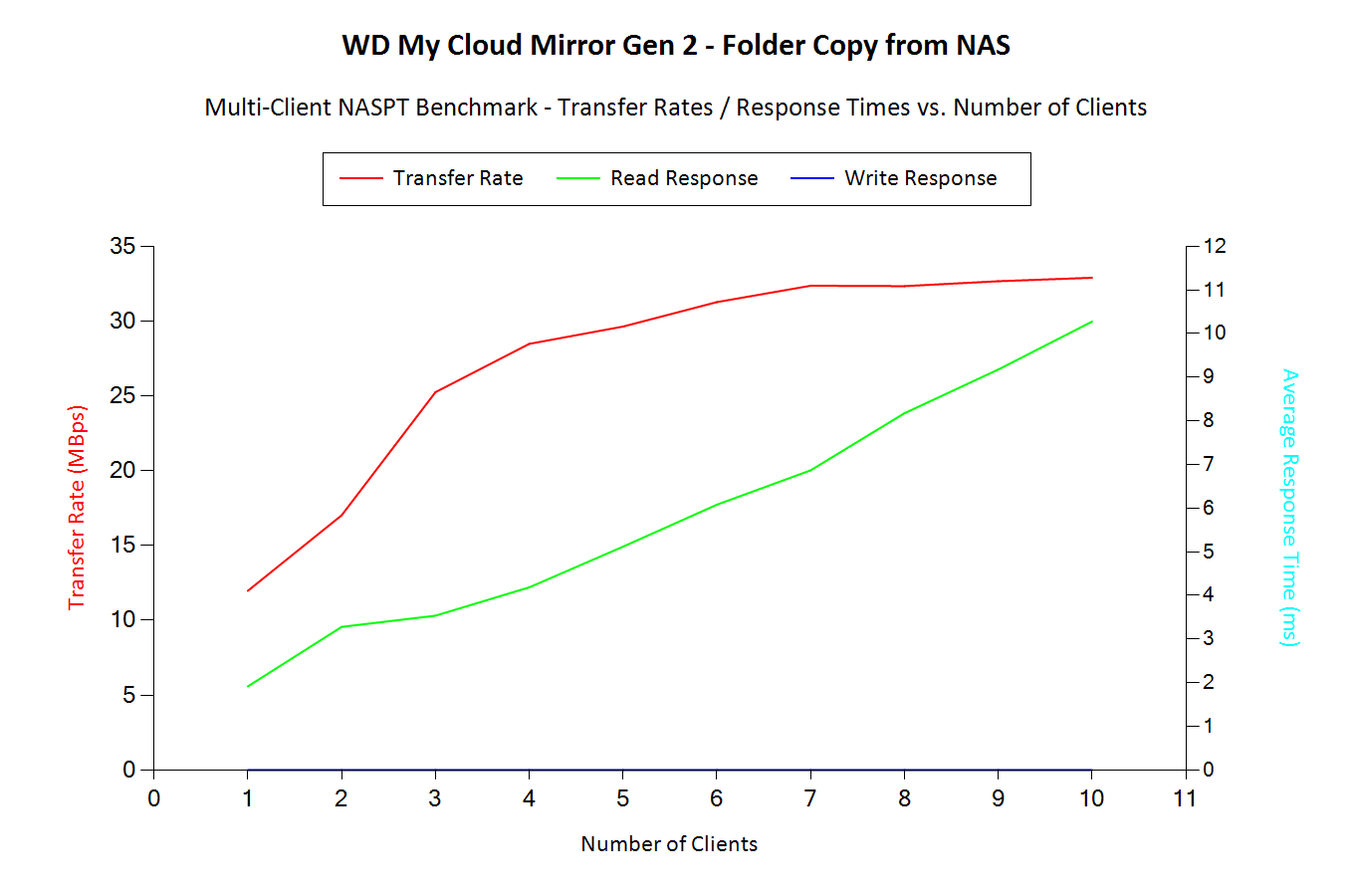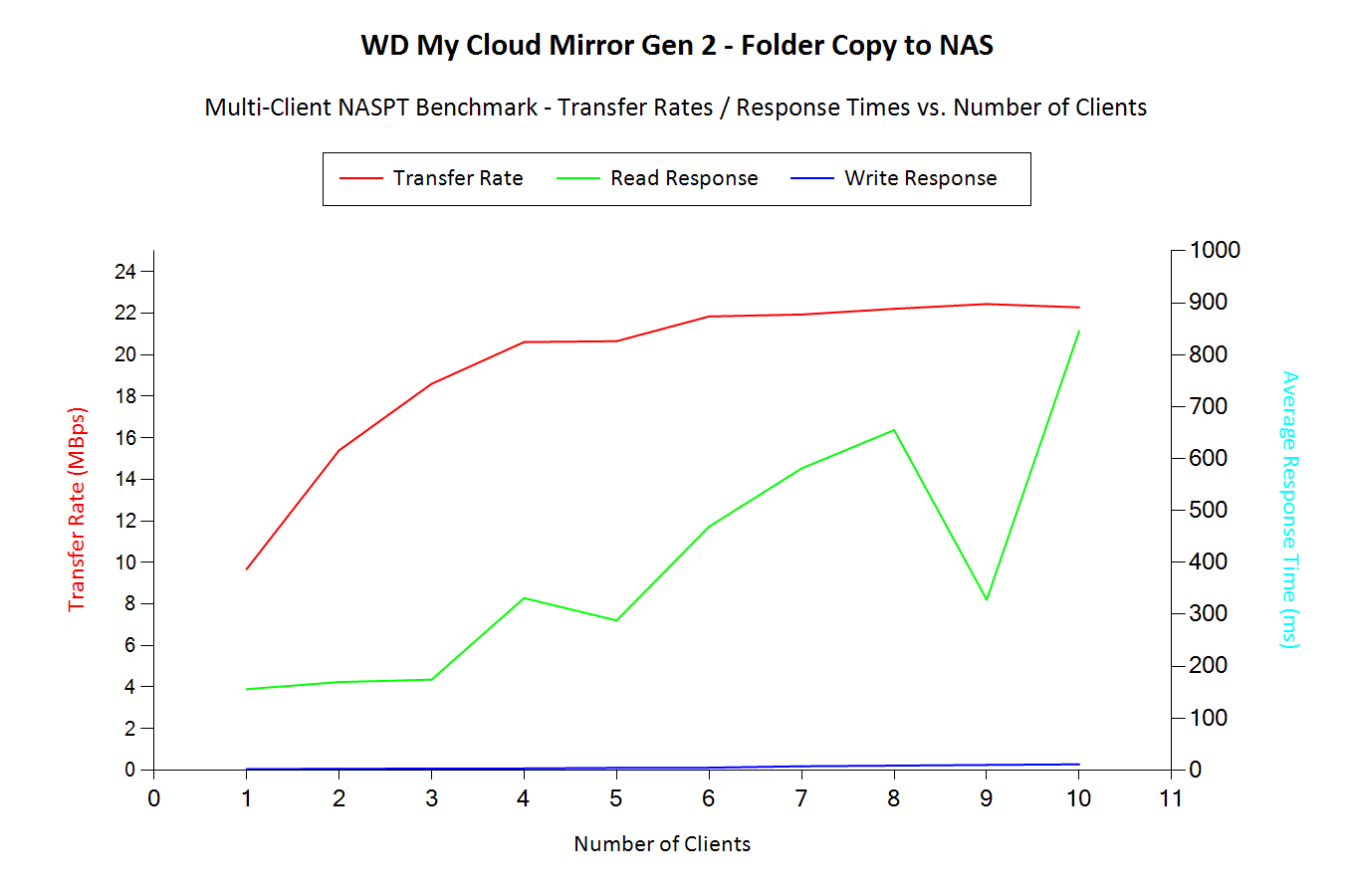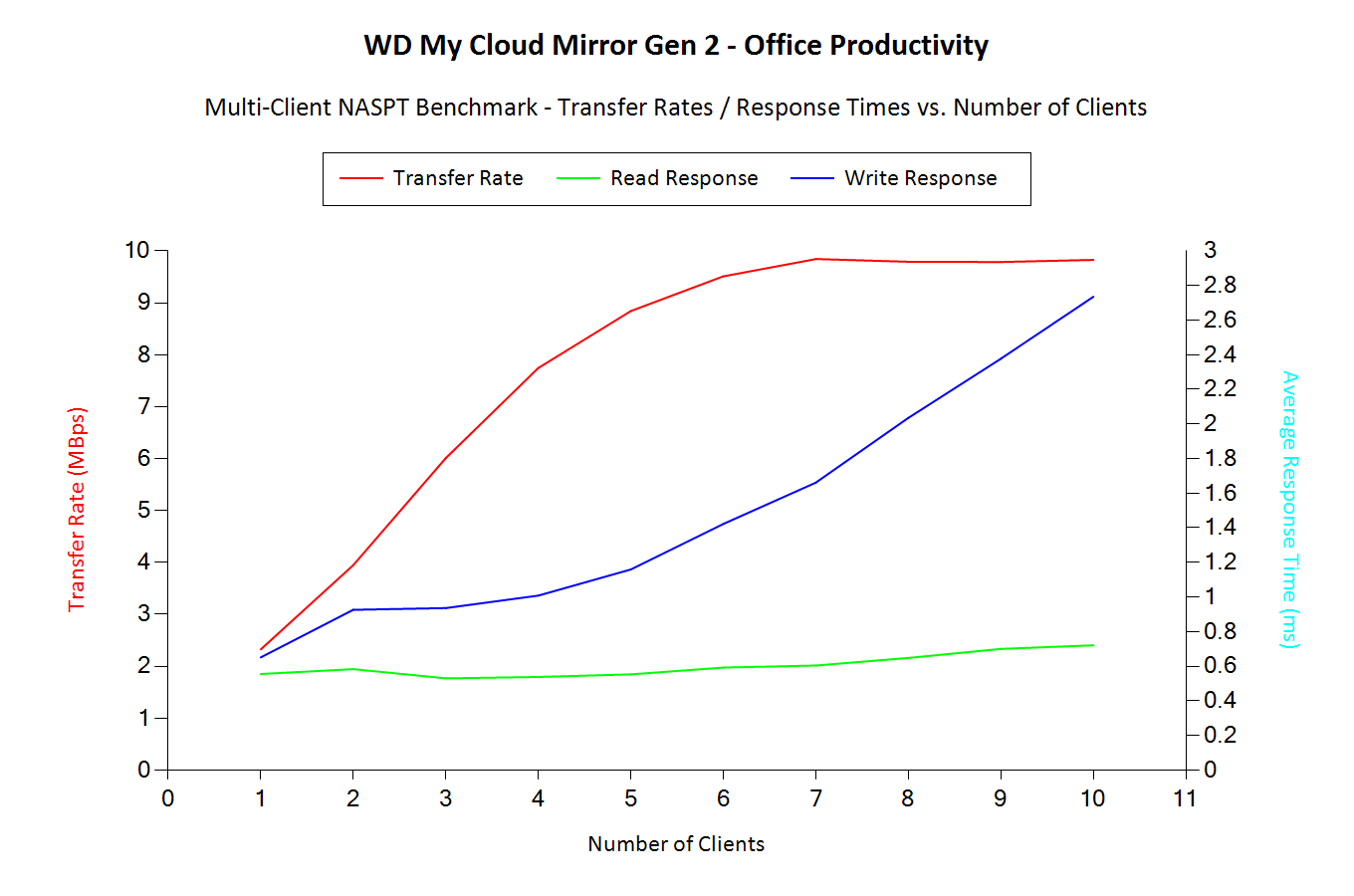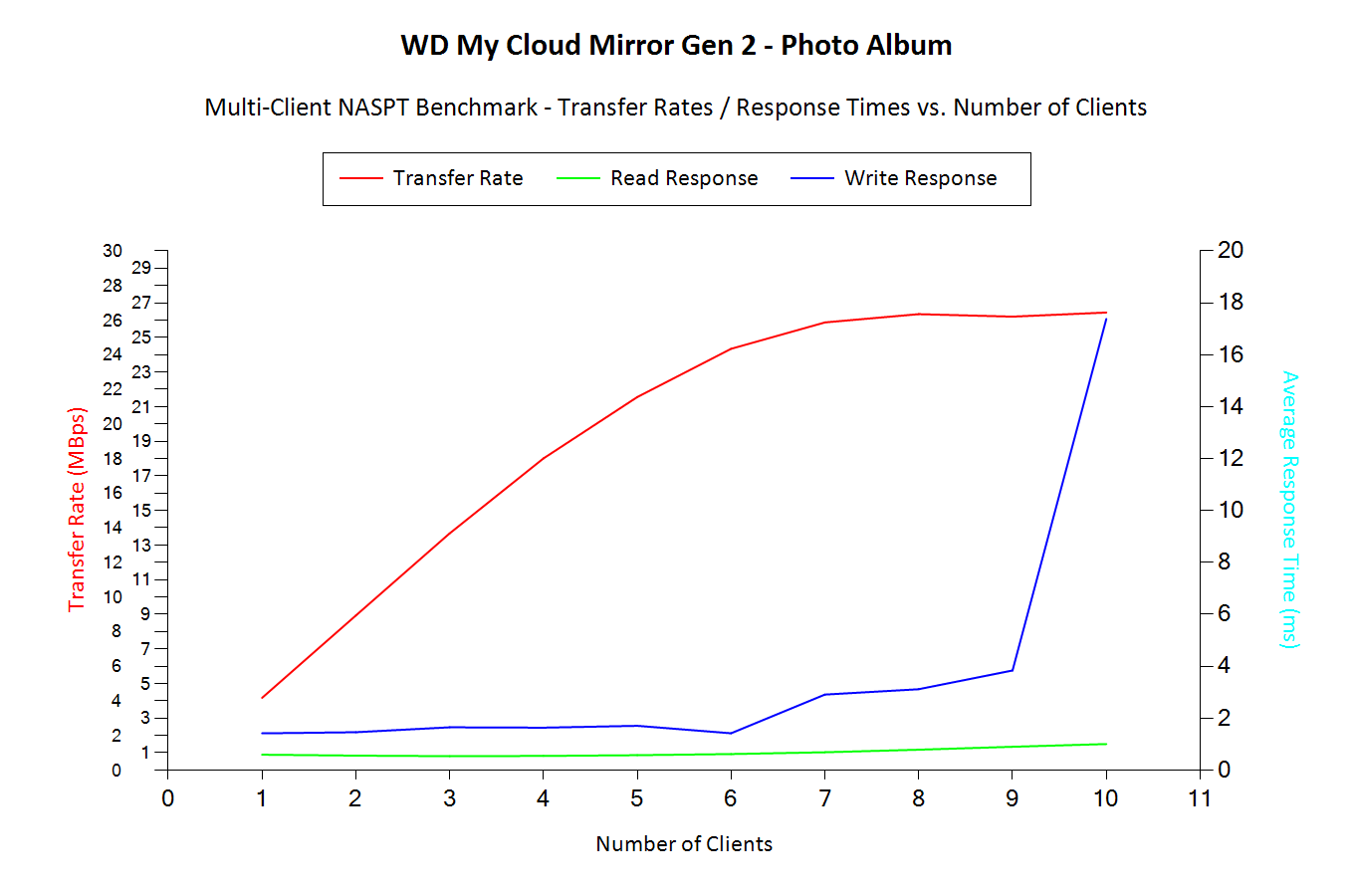Western Digital My Cloud Mirror Gen 2 Review
by Ganesh T S on October 9, 2015 8:00 AM EST- Posted in
- NAS
- Storage
- Western Digital
- My Cloud
Multi-Client CIFS Performance for Consumer Workloads
The workloads experienced by a NAS unit in a typical home consumer setting have changed quite a bit over the last few years. For example, multiple mobile devices in a typical household raise the possibility that a NAS could be subject to the streaming out of multiple video files simultaneously.
In our previous NAS reviews, we evaluated multi-client scenarios using synthetic workload traces and IOMeter. While there is nothing wrong in presenting numbers from such benchmarks, the reader is often left confused as to what those numbers might mean for his particular use-cases. Intel's NASPT benchmarking program gives us a good idea of the performance of the NAS unit when accessed by a single client. We took the source code of Intel's NASPT along with the supplied application traces and tweaked them to be able to run from more than one Windows client simultaneously in a co-ordinated manner. The graphs below present the results from tracking various metrics during the course of the benchmark runs. It must be noted that the average service times refer to what is obtained for all the traces when some of the data has already been cached in the client's memory. Unfortunately, NASPT doesn't provide any sort of guideline on what the optimal bandwidth and service times are for a good user experience.
Content Creation
The Content Creation workload seems to get acceptable performance for up to 3 clients. Beyond that, we have a noticeable drop in the per-client bandwidth numbers and the write response times also increase quite a bit. The detailed table with a breakdown of all the throughput numbers as well as the service times is available here

Folder Copy from NAS
The Folder Copy from NAS workload seems to get acceptable performance for up to 4 clients. Beyond that, even though we are not able to saturate the network link, the per-client bandwidth numbers start to fall down. The detailed table with a breakdown of all the throughput numbers as well as the service times is available here

Folder Copy to NAS
The Folder Copy to NAS workload seems to get acceptable performance for up to 4 clients. Beyond that, the total transfer rate saturates around 22 MBps. The detailed table with a breakdown of all the throughput numbers as well as the service times is available here

File Copy from NAS
The File Copy from NAS workload seems to get acceptable performance for up to 3 clients. Beyond that, we have a noticeable drop in the per-client bandwidth numbers. The detailed table with a breakdown of all the throughput numbers as well as the service times is available here

File Copy to NAS
The File Copy to NAS workload seems to get acceptable performance for up to 3 clients. Beyond that, the transfer rate saturates and actually drops beyond 8 clients with a noticeable uptick in the average response time. The detailed table with a breakdown of all the throughput numbers as well as the service times is available here

HD Video (1x) Playback
The HD Video (1x) Playback workload seems to get acceptable performance for up to 4 clients and actually manages to saturate the single GbE link. The detailed table with a breakdown of all the throughput numbers as well as the service times is available here
-Playback.png)
HD Video(1x) Playback and Record
The HD Video(1x) Playback and Record workload seems to get acceptable performance for up to 2 clients. Beyond that, we have a sharp drop in the per-client bandwidth numbers. The detailed table with a breakdown of all the throughput numbers as well as the service times is available here
-Playback-and-Record.png)
HD Video (1x) Record
The HD Video (1x) Record workload seems to get acceptable performance for up to 4 clients. The detailed table with a breakdown of all the throughput numbers as well as the service times is available here
-Record.png)
HD Video (2x) Playback
The HD Video (2x) Playback workload seems to get acceptable performance for up to 3 clients. Beyond that, we have a noticeable drop in the per-client bandwidth numbers. The detailed table with a breakdown of all the throughput numbers as well as the service times is available here
-Playback.png)
HD Video (4x) Playback
The HD Video (4x) Playback workload seems to get acceptable performance for up to 3 clients. Beyond that, we have a noticeable drop in the per-client bandwidth numbers. The detailed table with a breakdown of all the throughput numbers as well as the service times is available here
-Playback.png)
Office Productivity
The Office Productivity workload seems to get acceptable performance for up to 4 clients. Beyond that, we have a noticeable drop in the per-client bandwidth numbers. The detailed table with a breakdown of all the throughput numbers as well as the service times is available here

Photo Album
The Photo Album workload seems to get acceptable performance for up to 6 clients. Beyond that, we have a noticeable spike in the average response times. The detailed table with a breakdown of all the throughput numbers as well as the service times is available here

The detailed logs from the processing of our benchmarks - inclusive of metrics such as the file open times for each workload on each of the clients - can be found here










19 Comments
View All Comments
Goodspike - Saturday, October 10, 2015 - link
My concern about these consumer devices (and other consumer Cloud backup solutions) is how will the ISPs respond to having several thousand GB of data being constantly uploaded by each customer? On most my machines I try to avoid having my OS files uploaded to a Cloud service, but I wonder how many people do that. Someone could probably set one of these up in a manner where it would be uploading files 24/7.stephenbrooks - Sunday, October 11, 2015 - link
I imagine these are differential backups, so only modified files get transferred, based on comparison of file lists and modified dates (only a few MB for the whole disk).Also ISPs already have a bunch of BitTorrent people who upload constantly and they seem to cope with that (sometimes they get throttled).
bobbozzo - Sunday, October 11, 2015 - link
I don't think this is copying anything to WD's servers, except when you use remote access, then it downloads on-demand to the remote device, possibly via WD's network.Conficio - Saturday, October 10, 2015 - link
Really no IPv6 support? Is this 1999 or what? It's linux underneath, so one has to deliberately disable IPv6.ganeshts - Saturday, October 10, 2015 - link
It is all part of a differentiation drive when compared to the EX2 series.I suspect most of the consumers who are going to buy this unit probably don't even know what IPv6 is.
Sivar - Monday, October 12, 2015 - link
I've used two older WD EX2100 units (12TB) and have found WD's configuration interface to be the easiest to use of any NAS I have ever worked with. I think my grandma could set one up.Their software developers and UI designers deserve a medal.
whiteonline - Friday, October 16, 2015 - link
What SSH client is that?Moishe - Wednesday, November 4, 2015 - link
Thanks for mentioning the lack of features in this versus the EX2. Lack of encryption in this is a deal killer.mikato - Saturday, November 14, 2015 - link
I don't think you said anywhere in the article that this 4TB model comes with 2 x 2TB drives! I had to look at the photos to see that. You list "USD 310 (2x 2TB)" for the price entry in the specs table, but that doesn't say anything about which model it is for (I see it's the 4TB one). If set up as a mirror, as by default, and as the product is named, you only get 2TB or storage. They sell this as having capacity of 4TB. WD's website gives you no hint about this. I looked up the listing on Amazon and thank goodness they do have "4 TB 2X2TB" in the technical details, but otherwise there is no hint there either - actually when you choose the model at the top it says "Capacity" next to the 4TB which actually only gives you 2TB capacity.